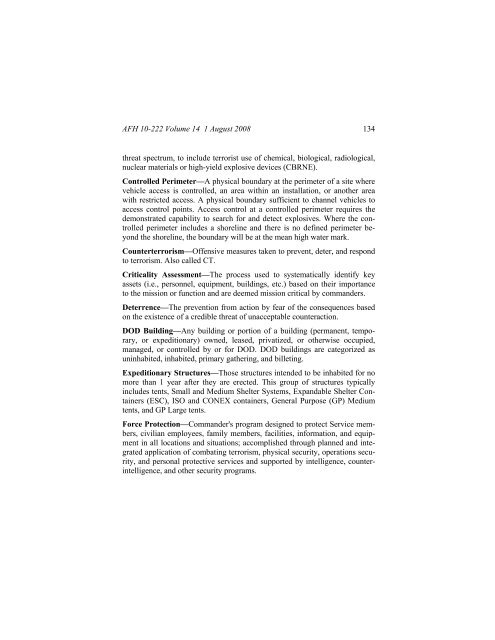Civil engineer guide to fighting positions, shelters, obstacles
Civil engineer guide to fighting positions, shelters, obstacles
Civil engineer guide to fighting positions, shelters, obstacles
You also want an ePaper? Increase the reach of your titles
YUMPU automatically turns print PDFs into web optimized ePapers that Google loves.
AFH 10-222 Volume 14 1 August 2008 134<br />
threat spectrum, <strong>to</strong> include terrorist use of chemical, biological, radiological,<br />
nuclear materials or high-yield explosive devices (CBRNE).<br />
Controlled Perimeter—A physical boundary at the perimeter of a site where<br />
vehicle access is controlled, an area within an installation, or another area<br />
with restricted access. A physical boundary sufficient <strong>to</strong> channel vehicles <strong>to</strong><br />
access control points. Access control at a controlled perimeter requires the<br />
demonstrated capability <strong>to</strong> search for and detect explosives. Where the controlled<br />
perimeter includes a shoreline and there is no defined perimeter beyond<br />
the shoreline, the boundary will be at the mean high water mark.<br />
Counterterrorism—Offensive measures taken <strong>to</strong> prevent, deter, and respond<br />
<strong>to</strong> terrorism. Also called CT.<br />
Criticality Assessment—The process used <strong>to</strong> systematically identify key<br />
assets (i.e., personnel, equipment, buildings, etc.) based on their importance<br />
<strong>to</strong> the mission or function and are deemed mission critical by commanders.<br />
Deterrence—The prevention from action by fear of the consequences based<br />
on the existence of a credible threat of unacceptable counteraction.<br />
DOD Building—Any building or portion of a building (permanent, temporary,<br />
or expeditionary) owned, leased, privatized, or otherwise occupied,<br />
managed, or controlled by or for DOD. DOD buildings are categorized as<br />
uninhabited, inhabited, primary gathering, and billeting.<br />
Expeditionary Structures—Those structures intended <strong>to</strong> be inhabited for no<br />
more than 1 year after they are erected. This group of structures typically<br />
includes tents, Small and Medium Shelter Systems, Expandable Shelter Containers<br />
(ESC), ISO and CONEX containers, General Purpose (GP) Medium<br />
tents, and GP Large tents.<br />
Force Protection—Commander's program designed <strong>to</strong> protect Service members,<br />
civilian employees, family members, facilities, information, and equipment<br />
in all locations and situations; accomplished through planned and integrated<br />
application of combating terrorism, physical security, operations security,<br />
and personal protective services and supported by intelligence, counterintelligence,<br />
and other security programs.
















